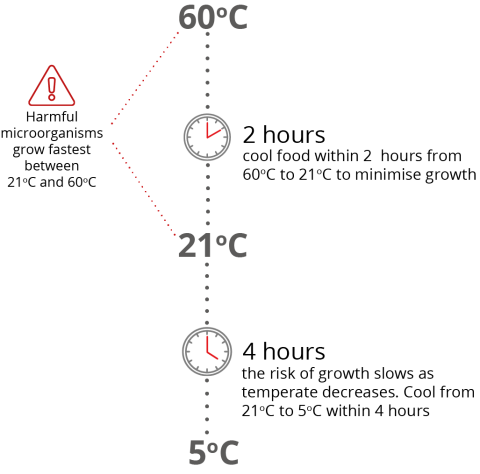When cooling or reheating food, it's important to do it right to keep it safe from harmful microorganisms and toxins that can cause food poisoning.
What are the requirements?
Under Standard 3.2.2 - Food Safety Practices and General Requirements, food businesses must make sure potentially hazardous food (like egg or meat dishes) is cooled or reheated quickly so harmful microorganisms don't get a chance to grow to unsafe levels.
If you are a food service business handling unpackaged, ready-to-eat, potentially hazardous food, you may need to substantiate your food safety controls for cooling food, under Standard 3.2.2A - Food Safety Management Tools.
Reheating
If you are reheating potentially hazardous food to hot hold, you must heat it quickly to 60°C or hotter - ideally in two hours or less.
Cooling
When cooling cooked potentially hazardous food, it must be cooled from 60°C to 21°C in two hours or less, then cooled further from 21°C to 5°C in four hours or less.
You can use a different cooling process but you must be able to show that it keeps the food safe.
Tips for cooling food quickly
- divide food into smaller portions in shallow containers to cool, being careful not to contaminate the food as you do this
- use rapid-cooling equipment (e.g. a blast chiller)
- stir liquid foods such as gravy often, using a clean and sanitised utensil
- use water or ice water baths
- allow air to flow freely around the cooling container (e.g. on a rack rather than the floor)
- add ice as an ingredient
- check temperature with a probe thermometer.
Tips for heating food quickly
- use a microwave, oven or stove top to rapidly reheat it to at least 60°C
- don't heat food using bain maries, pie warmers or other equipment designed only to hold food hot - this is likely to take too long or not heat the food enough to keep it safe
- heat food to 60°C or hotter before transferring to hot-holding equipment
- avoid reheating potentially hazardous food more than once, so it doesn't go through multiple warming periods
- check temperature with a probe thermometer.

